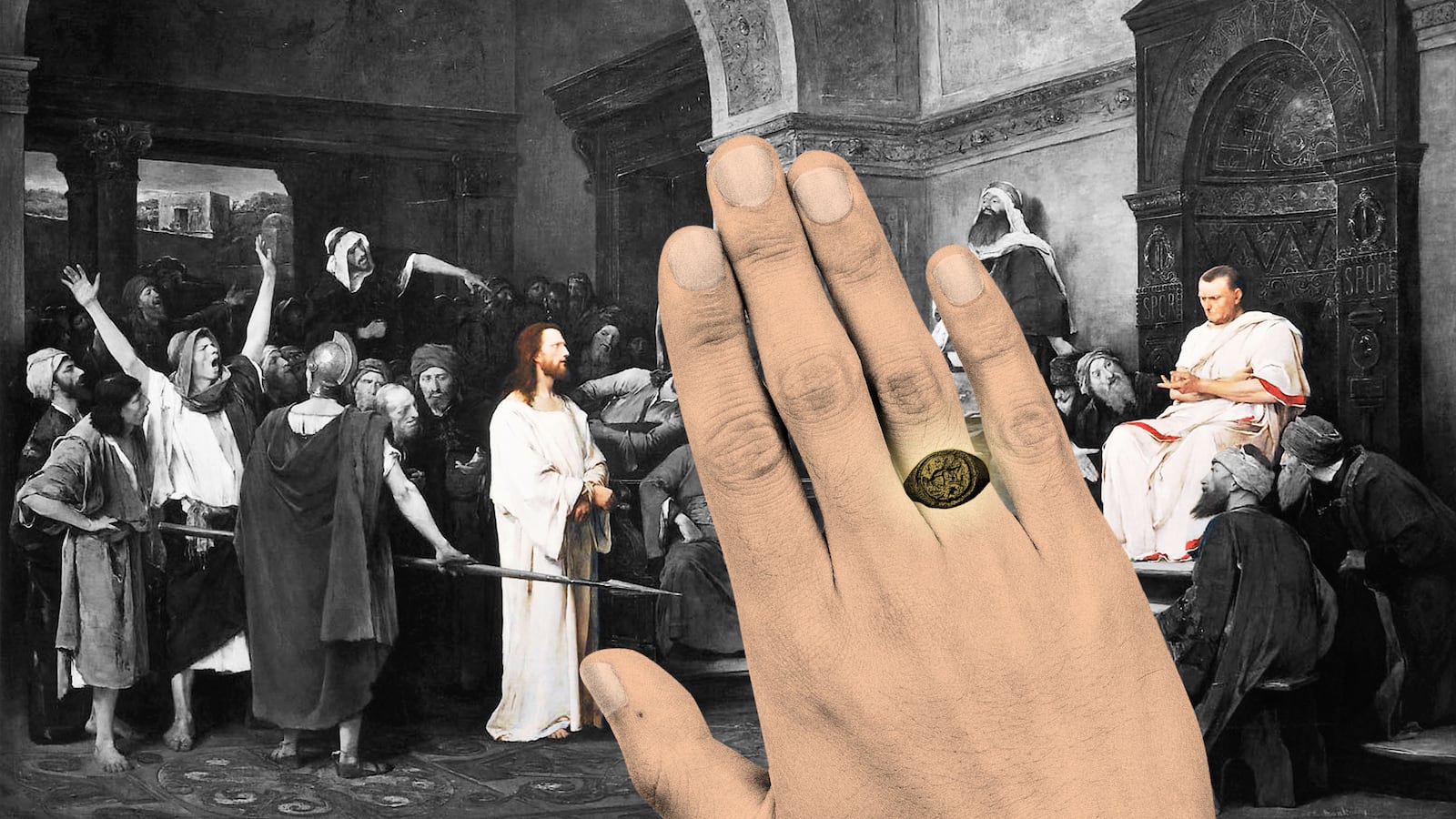Fifty years ago, while excavating at Herodium, near Bethlehem in the West Bank, archaeologist Gideon Forster discovered a bronze ring. It was one of thousands of finds and its discovery did not cause a stir at the time. But now, half a century later, the ring has been cleaned and deciphered and scientists are claiming that it belonged to Pontius Pilate, the man who sentenced Jesus to death.
The ring was discovered in 1968-69, shortly after the conclusion of the Six Day War. From there, the items discovered at the site were passed to the current team of archaeologists who work on the site. It was only when the ring was cleaned and photographed using special equipment at the Israel Antiquities Authority labs that the inscription on the ring became visible. The ring includes a picture of a wine vessel, surrounded by the word “Pilatus.”
The most famous Pilate in the ancient world was Pontius Pilate, the fifth prefect of the Roman province of Judea from roughly 26-36 A.D.. Pilate is best known to us from the New Testament, in which he is the man responsible for passing final judgment on Jesus. The Gospels present Pilate as an almost sympathetic character who only reluctantly agreed to condemn Jesus to death, but other historical sources suggest that he was a hardened military man unwilling to demonstrate much sensitivity towards the religious sensibilities of the Jews.
The Jewish historian Josephus tells us that while other Roman prefects had removed effigies from their standards when they came into Jerusalem, Pilate allowed his soldiers to march the standards into the city at night. The incident caused uproar and was faced with demonstrators willing to die for their beliefs, Pilate had to back down. This wasn’t the only occasion on which Pilate insulted the Jewish people: at one point the emperor Tiberius had to berate Pilate for putting gold-coated shields on display in Herod’s palace. The first-century philosopher Philo describes him as vindictive, having a temper, and inflexible.
This ring would not be the only archaeological evidence of the existence of Pilate. In 1961, archaeologists unearthed a limestone block with an inscription mentioning “Pontius Pilate” as the “prefect of Judea” at Caesarea Maritima, a Roman port on the coast of the Mediterranean in Israel. The discovery provided tangible first-century evidence of the existence and career of Pilate in the region.
Now, with the discovery of what is potentially Pilate’s ring, we may have a second piece of evidence to ground history’s most famous story. As Professor Danny Schwartz remarked, “[we] don’t know of any other Pilatus from the period and the ring shows he was a person of stature and wealth.” There are, unfortunately, some things we still don’t know. The Herodian excavation site covers the fortress built by King Herod the Great. After his death, the upper part of the fortress complex continued to be used by Roman governors. It is possible that Pilate used the site for administrative purposes. But because the ring was discovered 50 years ago, we have little information about the circumstances of its discovery. Thus we can’t use that context to figure out when it was deposited in the ground. Nor is there a detailed explanation as to why the item took so long to identify.
Of course, the existence of a tangible artifact does not necessarily tell us much more about who Pilate actually was. And it’s unclear that early Christians were that interested in the historical Pilate himself. From the composition of the Gospels onward, followers of Jesus presented Pilate as an unwilling accomplice to the murder of the messiah. This is despite the fact that other historical sources depict Pilate as more than eager to execute those he considered to be a threat to his authority. In the second century, Christian writers went even further in their efforts to exonerate him. A fragmentary apocryphal story known as the Gospel of Peter has Pilate declare that he is “pure from the blood of the Son of God.” Christians worked to exculpate Pilate because blaming the Romans was poor advertising for the Christian movement. As a consequence, of course, they ended up blaming Jewish leaders and the Jews in general for the crucifixion, despite the fact that Jewish leaders did not have the authority to condemn anyone to death. The misrepresentation has contributed to the rise of anti-Semitism from late antiquity until the present day.
In some later traditions Pilate’s wife (who attempted to prevent Pilate from executing Jesus), and even Pilate himself, is commemorated as a saint. In others Pilate is supposed to have committed suicide out of remorse for having been involved in the death of Jesus. Most astonishing of all, the second-century theologian and bishop Irenaeus of Lyon stated that heretical Christians claimed to possess a portrait of Jesus painted by none other than Pilate himself. As ridiculous as it sounds, the rumor was not easy to put to rest: in the medieval period a forged letter, purporting to be by Pilate, circulated claiming to contain an eyewitness portrait of the face of Jesus.
There are still unanswered questions about this new “Pilate ring” and the circumstances of its discovery. But one thing is for sure: material evidence of Pilate’s life will not prevent Christians from re-reading him as a kind of ambiguous hero. After all, we’ve been doing it for nearly 2,000 years.







